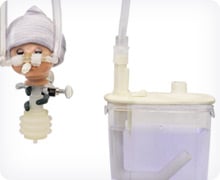
Problem being addressed[edit | edit source]
There is a need for safe, affordable, and easy-to-use assistive respiratory devices that allow newborn infants to breath spontaneously without the need for mechanical ventilation. Infants in resource-limited settings will often not receive the necessary respiratory support due to lack of ventilators, which are often prohibitively expensive.
Detailed description of the solution[edit | edit source]
The Seattle Children's Positive Airway Pressure, or Sea-PAP, device provides the necessary respiratory assistance when a premature infant is not in need of full mechanical ventilation. The Sea-PAP device improves on conventional designs by adjusting the angle at which the expiratory tube is inserted into the water. The change in angle is sufficient to improve the oscillatory nature of respiration, which is important to the development of the infant.
Designed by[edit | edit source]
- Designed by: The Neonatal Respiratory Support Technologies Team as part of the Seattle Children's Hospital
Testing/Implementation[edit | edit source]
Clinical trials are currently in development.
Funding Source[edit | edit source]
$2.3 million was awarded from the Bill and Melinda Gates Foundation in April 2011.
References[edit | edit source]
Other internally generated reports[edit | edit source]
Seattle Children's. (2011.) Seattle Children's invention lands major funding with hopes of saving thousands of infant lives globally each year. Link available here.